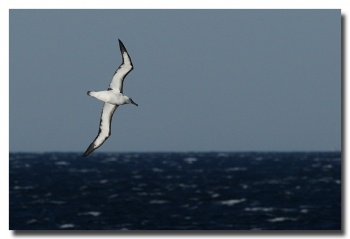Alternative name: Mollymawk is an alternative name for small Albatross species
- Thalassarche carteri
Thalassarche bassi
Identification
Length 71-81 cm (28-32¼ in). Wingspan 180-215 cm.
Adult: Upperwings blackish, connected across the back by back blackish-grey; rump white, tail dark grey and underparts white. Under-wing white with black tip and margins, broadest on leading edge. Head and neck sides and rear at most pale grey with white crown and chin (grey frequently only a hint on sides of head). Area around the eye includes a small blackish eye-brow, more prominent in front. Iris brown, bill black with narrow yellow stripe at the culmen becoming pinkish near the tip. Legs are bluish-pink.
Immature: as adult but head whiter and bill all-dark.
Similar Species
Most difficult to separate from Atlantic Yellow-nosed Albatross, which differ in having a more visible grey hood, and a stronger black marking in the eye-brow which does extend below the eye. Additionally, the yellow stripe at the culmen ends in a rounded point, rather than sharp as in Indian Y-n.A.
Identified by combination of bill-colour and underwing pattern which is intermediate between Black-browed and White-capped Albatross.
Distribution
Breeds on Prince Edward, Crozet, Kerguelen, Amsterdam, and St Paul Islands in the southern Indian Ocean. Outside of breeding, this species is highly pelagic, ranging from eastern southern Africa to southern Australia and the Tasman Sea, and less commonly to New Zealand.
Taxonomy
Formerly considered the same species as Atlantic Yellow-nosed Albatross.
Scientific name bassi is a junior synonym of carteri.
Diomedea vs. Thalassarche
Genera Phoebastria and Thalassarche formerly placed in the Diomedea, but now considered by virtually all authorities (Clements, Howard & Moore, AOU, BOU, SACC) to be separate genera in light of Nunn et al. (1996) [4] and Penhallurick & Wink (2004) [5].
Subspecies
This is a monotypic species[1].
Habitat
Breeds on slopes of cliffs of islands, often in places lacking vegetation. It spends the rest of its life at sea.
Behaviour
Feeds on prey captured on the surface or within about the top meter. It captures e.g., squid but also takes offal from for example fishing vessels.
Breeding starts around end of September, and the young fledges the following March to April. Most pairs breed again next year.
Vocalisation
Known to produce both ailing and croaking calls.
References
- Clements, J. F., P. C. Rasmussen, T. S. Schulenberg, M. J. Iliff, T. A. Fredericks, J. A. Gerbracht, D. Lepage, A. Spencer, S. M. Billerman, B. L. Sullivan, and C. L. Wood. 2023. The eBird/Clements checklist of Birds of the World: v2023. Downloaded from https://www.birds.cornell.edu/clementschecklist/download/
- Gill, F, D Donsker, and P Rasmussen (Eds). 2023. IOC World Bird List (v 13.2). Doi 10.14344/IOC.ML.13.2. http://www.worldbirdnames.org/
- del Hoyo, J., C. Carboneras, F. Jutglar, N. Collar, and G. M. Kirwan (2023). Indian Yellow-nosed Albatross (Thalassarche carteri), version 1.0. In Birds of the World (F. Medrano and B. K. Keeney, Editors). Cornell Lab of Ornithology, Ithaca, NY, USA. https://doi.org/10.2173/bow.yenalb3.01
- Nunn, G. B., J. Cooper, P. Jouventin, C. J.R. Robertson and G. G. Robertson. 1996. Evolutionary relationships among extant albatrosses (Procellariiformes: Diomedeidae) established from complete cytochrome-B gene sequences. Auk 113 (4):784-801.
- Penhallurick, J. and M. Wink. 2004. Analysis of the taxonomy and nomenclature of the Procellariiformes based on complete nucleotide sequences of the mitochondrial cytochrome b gene. Emu 104:125-147.
Recommended Citation
- BirdForum Opus contributors. (2025) Indian Yellow-nosed Albatross. In: BirdForum, the forum for wild birds and birding. Retrieved 26 April 2025 from https://www.birdforum.net/opus/Indian_Yellow-nosed_Albatross
External Links
GSearch checked for 2020 platform.1






